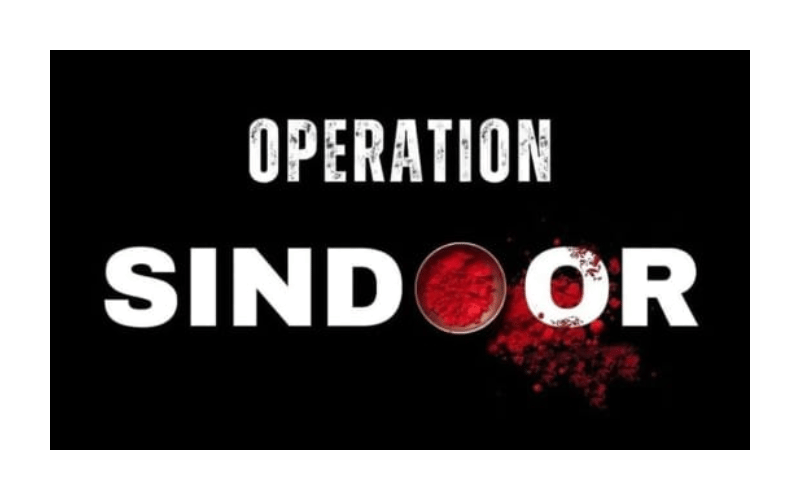In May 2025, India took Operation Sindoor, strong military action against this barbaric terrorist attack in Pahalgam, Kashmir, which left 26 civilians dead. This was not a tactical move but a deeper statement of mixing military strategy with cultural symbolism against India’s defiance against terrorism and protection of national integrity.
The Catalyst: Pahalgam Attack
On 22nd April 2025, militants attacked a bus carrying tourists in Pahalgam, killing 26 civilians who were mostly Hindu men. This attack was one of the most brutal ones since the 2008 Mumbai attacks and was blamed on terrorist groups based in Pakistan, such as Jaish-e-Mohammed and Lashkar-e-Taiba. The reaction from the Indian government was quick and strong, and this prompted the commencement of Operation Sindoor on the 7th May 2025.
Symbolism in the Name “Sindoor”
The term Sindoor refers to the traditional red vermilion powder worn by the married Hindu women on the parting of their hair, as a symbol of marital status and husband’s well-being. The selection of this name for the military operation was very symbolic as it would be the nation’s way of mourning those widows spawned by the Pahalgam attack and to promise protection of its citizens. This cultural reverberation was manifested even further when 17 newborn girls in Kushinagar, Uttar Pradesh, were christened ‘Sindoor’ in commemoration of the operation, demonstrating the strong feelings and national pride involved in the undertaking.
Execution and Scope of the Operation
Operation Sindoor, which took place with precision, was aimed at dismantling the terrorist infrastructure in nine areas of Pakistan-administered Kashmir and Pakistan’s Punjab Province. The Indian Air Force used Rafale fighters that have SCALP missiles, AASM Hammer bombs that were used to make the strikes last 23 minutes. The operation was targeted at destroying the terrorist capability of the groups that launched the Pahalgam attack. The Indian military presented what it touted as the result of its precision strikes, pointing to severe damage to Pakistan’s Rahim Yar Khan airbase, where a massive crater due to missile impact was revealed. Moreover, the visuals of the Nur Khan airbase were shown to exhibit the strategic and destructive precision of the Indian Air Force’s operations.
Strategic and Political Implications
Neither the operation nor the objective of its target signified a change in India’s defense policy, promoting a proactive approach towards counter-terrorism. In his national address, Prime Minister Narendra Modi emphasized that there will be no tolerance of any kind of terrorism or nuclear blackmail from India and that peace cannot be in existence with terror. He directly denounced Pakistan on charges of state-supported terrorism, stating that any further dialogue could only be about terrorism and Pakistan-occupied Kashmir (PoK).
International Reactions and Ceasefire
The developments took a global interest as different nations pleaded for calm. Immediately after communications between the Directors General of Military Operations of India and Pakistan, there was a ceasefire on May 10, 2025. However, both countries blamed each other with violating the agreement on ceasefire few days after the implementation. US VP JD Vance warned about the possible escalation and called upon Pakistan to cooperate with India in fighting terrorism.
Legacy and Continuing Impact
Operation Sindoor has left a permanent mark on the Indian defense doctrine, a combination of military efficiency and a cultural rapport. It is a testimony of India’s determination to fight terrorism and keep its people safe. The name of the operation still reflects the sense of national unity and stubbornness, enforcing the idea that any assault against the people of India will receive undeterred strength and determination.
Psychological Warfare and Public Sentiment
Other than military incursions, Operation Sindhur was a type of psychological war, domestically and across the border. For the Indian citizen who was still in shock due to the attack on Pahalgam, no better thing has ever happened than the operation, which gave them a sense of justice as well as national pride. The fact that the symbolic name reverberated with cultural identity enhanced this effect. On the other hand, the operation gave a strong message to militant groups and their supporters that India was going to retaliate swiftly and strongly. It also sought to discourage future attacks through demonstration of political will as well as military prowess.
Digital Diplomacy and Narrative Control
Unlike the previous wars, Operation Sindhur was followed by an aggressive digital publicity. Indian officials dropped satellite imagery, strike scenes, and humanitarian stories surrounding the symbolism of “Sindoor” on social media platforms and through press briefings. This was essential in influencing the operation as not only retaliation, but also as a culturally oriented and morally righteous step. The authoritarian control that the Indian government exercised on the digital narrative allowed it to preempt international criticism, manipulate domestic opinion, and counter possible misinformation campaigns in the enemy’s hands. This digital diplomacy initiative came in handy in mobilizing national as well as diaspora support.
Civilian Mobilization and Grassroots Support
There was also an unanticipated grassroots mobilization that was affected by Operation Sindoor. From candlelight vigils to fundraisers for victims’ families, the Indian civil society had a major role. NGOs, women’s groups, and student bodies got behind the emblematic value of the mission. In such towns as Kushinagar, where several newly born babies were christened as “Sindoor”, the mission rose above a military campaign. It was adopted as a national emotive solidarity movement. This civilian support was a bottom-up push on the leaders of politics to adopt a hard stance on security and justice for victims of terror.

Pakistan’s Internal Fallout
While India was celebrating military success, Operation Sindoor was causing major internal debates in Pakistan. There were political arguments on military preparedness and intelligence failure. Some media houses wondered if Pakistan’s patronage of militant proxies had come back to bite. Reports also mentioned a short-term lull in public morale, particularly in border areas (where Pakistan’s airbases were under the scanner). Islamabad formally denied the devastation, but leaked videos and international satellite monitors showed otherwise, rousing opposition voices at home and doubts about Pakistan’s capabilities.
Long-Term Strategic Outlook
Over the long term, Operation Sindoor may fundamentally change the counterterrorism playbook of the country. Defense analysts guess that India may further use culturally appropriate operation codenames as a mechanism of national integration. Such success may also speed up investments in precision-strike capabilities, satellite surveillance, and AI-based defense tech. Besides, the geopolitical arithmetic can change, and India can take the position of an example of ethically oriented but hardline military response. In case institutionalized, operation Sindoor can turn into a case study in terms of hybrid warfare where stratagem, symbolism, and the support of the people merge to craft a new age doctrine of defending.
Humanitarian Impact and Response from Kashmir
Although Operation Sindoor was a retaliatory military action, its humanitarian implications, especially in Kashmir, cannot be overlooked. In this region, which has been embroiled in the conflict for years, a continuous humanitarian crisis is taking place. Thousands of civilians live in fear for their lives, as violence occurs regularly. Nevertheless, the Indian government’s attempts to make sure that the operation aimed at the only terrorist infrastructure rather than causing indiscriminate harm against civilians were apparent through the meticulous planning and execution of the mission. Humanitarian organizations warned about the consequences, saying that there was a necessity to pursue peace measures together with military operations.
The Role of Intelligence and Cyber Warfare
Operationally, behind the success of Operation Sindoor was a wide intelligence network that was crucial in ascertaining the terrorist infrastructure to be targeted in the operation. Modern warfare does not only refer to being armed with conventional military power, but rather it is the exploitation of technological intelligence. India’s defense establishment, with a mix of human intelligence (HUMINT), signals intelligence (SIGINT), and satellite surveillance, singled out terrorist hideouts with surgical precision. Moreover, cyber warfare was a clandestine but vital element of the operation, given that cyber attacks were probably used to jam enemy communication lines and frustrate their logistics operations before the airstrike took place.
Lessons from Past Conflicts and Evolving Defense Policy
The value of Operation Sindoor is not only from the effects in the short term, but it is also in the lessons learnt from previous operations. The solution to counterterrorism in India has changed throughout the years and has progressed from reactive solutions towards more proactive and precision-oriented ones. Contrary to the 1999 Kargil war, where India was strategically at a loss, or the 2008 Mumbai attacks, where failures in intelligence were apparent, Operation Sindoor showed India’s sophisticated military functions and all-inclusive planning. The utilization of high-technology and expeditious decision-making and global narrative management represented a dramatic change in the defense policy of India that was more focused on preemptive measures against terrorism.
A Turning Point in India’s Counterterrorism Strategy
The operation Sindoor has become a turning point in combating terrorism in India. It not only spoke of a change towards precision strikes and proactive defense measures but also penetrated the deepest of the cultural and national psyche of India. It was a clear message sent down to Pakistan and the world that from now on, India would not remain passive over the question of terrorism.














